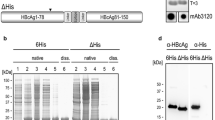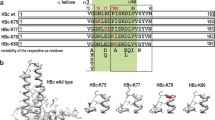Summary.
Hepatitis B core antigen is one of the most promising protein carriers of foreign epitopes of various human and animal pathogens. Chimeric HBcAg particles can be used as effective artificial immunogenes. Unfortunately, not all chimeric proteins are able to be particulated. The dependence of correct or incorrect folding of chimeric proteins on physical and chemical properties of inserts was studied with the help of ProAnalyst, SALIX and QSARPro computer programs. We have found that insertion of amino acids with high hydrophobicity, large volume, and high β-strand index prevent self-assembling chimeric proteins. These factors are most important for the C-termini of inserts. Recommendations for obtaining correct folding of chimeric HBcAg particles have been given.
Similar content being viewed by others
Author information
Authors and Affiliations
Additional information
Received August 8, 1999, Accepted September 26, 1999
Rights and permissions
About this article
Cite this article
Karpenko, L., Ivanisenko, V., Pika, I. et al. Insertion of foreign epitopes in HBcAg: how to make the chimeric particle assemble. Amino Acids 18, 329–337 (2000). https://doi.org/10.1007/s007260070072
Issue Date:
DOI: https://doi.org/10.1007/s007260070072




